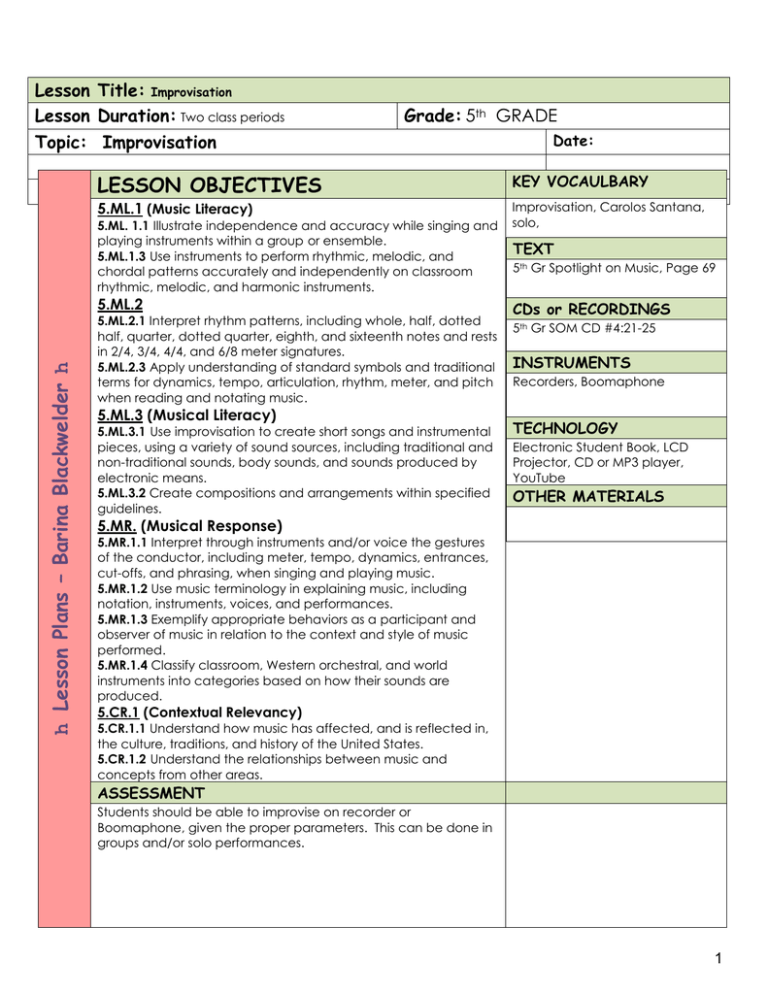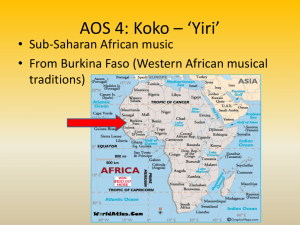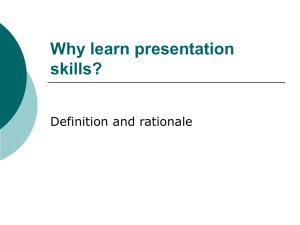Blackwelder 5th gr Improvisation
advertisement

Lesson Title: Improvisation Lesson Duration: Two class periods Grade: 5th GRADE Topic: Improvisation LESSON OBJECTIVES KEY VOCAULBARY 5.ML.1 (Music Literacy) Improvisation, Carolos Santana, solo, 5.ML. 1.1 Illustrate independence and accuracy while singing and playing instruments within a group or ensemble. 5.ML.1.3 Use instruments to perform rhythmic, melodic, and chordal patterns accurately and independently on classroom rhythmic, melodic, and harmonic instruments. 5.ML.2 h Lesson Plans – Barina Blackwelder h Date: 5.ML.2.1 Interpret rhythm patterns, including whole, half, dotted half, quarter, dotted quarter, eighth, and sixteenth notes and rests in 2/4, 3/4, 4/4, and 6/8 meter signatures. 5.ML.2.3 Apply understanding of standard symbols and traditional terms for dynamics, tempo, articulation, rhythm, meter, and pitch when reading and notating music. 5.ML.3 (Musical Literacy) 5.ML.3.1 Use improvisation to create short songs and instrumental pieces, using a variety of sound sources, including traditional and non-traditional sounds, body sounds, and sounds produced by electronic means. 5.ML.3.2 Create compositions and arrangements within specified guidelines. TEXT 5th Gr Spotlight on Music, Page 69 CDs or RECORDINGS 5th Gr SOM CD #4:21-25 INSTRUMENTS Recorders, Boomaphone TECHNOLOGY Electronic Student Book, LCD Projector, CD or MP3 player, YouTube OTHER MATERIALS 5.MR. (Musical Response) 5.MR.1.1 Interpret through instruments and/or voice the gestures of the conductor, including meter, tempo, dynamics, entrances, cut-offs, and phrasing, when singing and playing music. 5.MR.1.2 Use music terminology in explaining music, including notation, instruments, voices, and performances. 5.MR.1.3 Exemplify appropriate behaviors as a participant and observer of music in relation to the context and style of music performed. 5.MR.1.4 Classify classroom, Western orchestral, and world instruments into categories based on how their sounds are produced. 5.CR.1 (Contextual Relevancy) 5.CR.1.1 Understand how music has affected, and is reflected in, the culture, traditions, and history of the United States. 5.CR.1.2 Understand the relationships between music and concepts from other areas. ASSESSMENT Students should be able to improvise on recorder or Boomaphone, given the proper parameters. This can be done in groups and/or solo performances. 1 SUMMARY OF TASKS / ACTIONS 1. 2. 3. 4. 5. 6. 7. 8. 9. 10. Have students guess the mystery performer (Carlos Santana) by putting the following clues on the board. Born in 1947 Mexican-born, male guitarist US citizen Has won numerous Grammy awards. Is frequently a guest soloist on other artist’s projects. Was inducted into the Rock and Roll Hall of Fame in 1998. His band’s name is Santana. Display page 69 in electronic book and have a student read the paragraph about Carlos Santana. Have students pronounce lyrics of “Oye Como Va” using CD 4:25. Discuss the meaning of improvisation. Watch a performance of this piece using: http://www.youtube.com/watch?v=DoIqXz2AIFs Discuss which instrumentalists improvised and how many times they did so in this performance. Practice singing the piece using CD 4:22. Introduce improvisation during the interlude using the following parameters: On recorder or Boomaphone, use the following pitches: Low D, G, A. Use repeated syncopated rhythms to align with the style of the piece. Let half the class improvise while the other half listens. Switch groups. Let any students play solos when they feel comfortable. 2nd class Extension: Performance for a younger audience (kindergarten) 1. Invite class to come in while older class teaches them about Carlos Santana using the above clues. 2. Students should explain the definition of improvisation. 3. Students explain that they will sing a song in Spanish that they will learn to sing. 4. Older students improvise during interlude on recorders and Boomaphone. 5. If there is time, have younger students pair up with an older student in order to work on the lyrics. Once both classes are ready to share, they can sing the song together and free-style dance during the interlude, which is a type of improvisation. REFLECTION / CLASS GRADES Students receive a participation grade and a grade concerning their attempts at improvisation. Students also receive extra points for actively sharing with the younger class. 2






